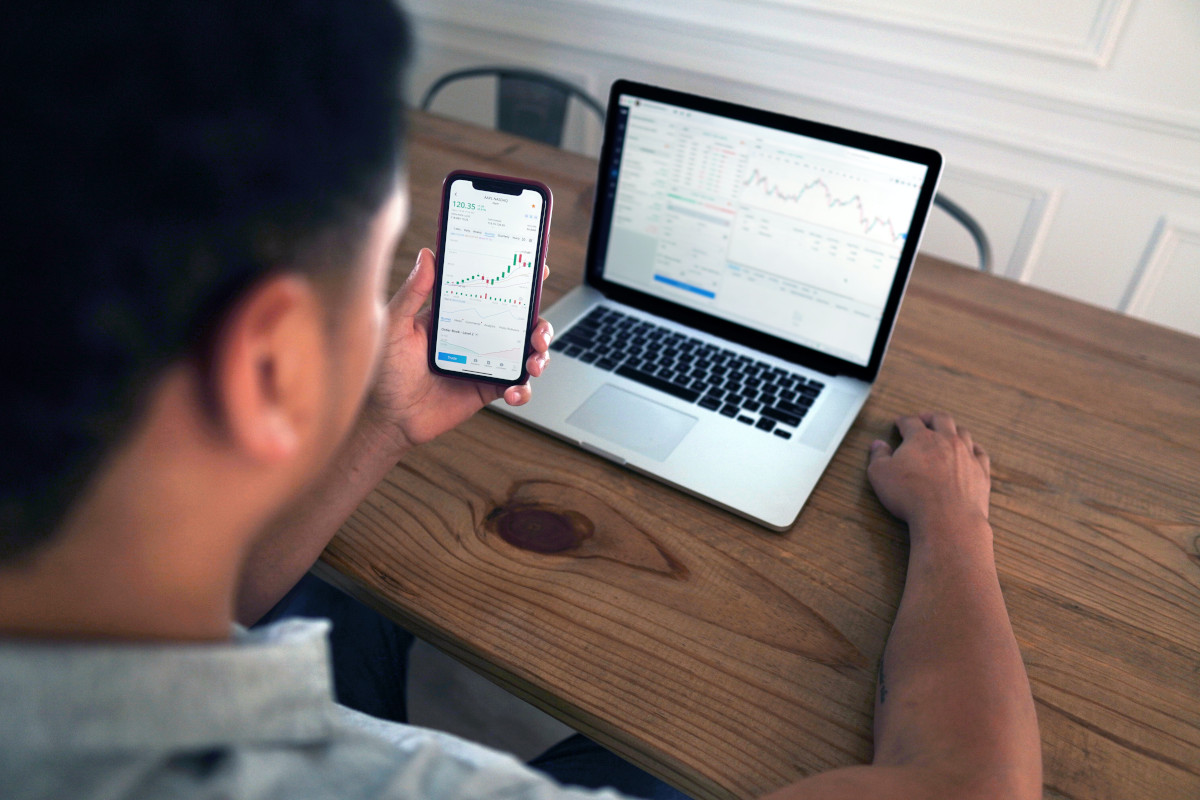Even for seasoned traders, investing can often feel like an expedition into the unknown. With market conditions shifting as unpredictably as ocean tides, it’s understandable if you find yourself questioning whether you’re navigating the waves or merely being swept along.
For many investors, one phrase surfaces repeatedly, presenting itself as a lifeline to potentially secure higher trading profits: buy the dip, sell the rip.
But what does it mean to buy the dip? More importantly, how can you harness this strategy effectively to earn more profits while minimizing downside potential?
You’ve come to the right place to learn how to buy the dip. Below, you’ll uncover the secrets that investors use to consistently identify the dip at the right time. We’ll also offer our own insights to help you execute the strategy yourself so you can feel confident enjoying the higher profit potential that comes with this strategy.
Just as a seasoned captain steers his ship through a storm with, you’ll soon be navigating the ebb and flow of market trends with ease and confidence. So sit tight, as we are about to set sail on a voyage of discovery that will forever change the way you approach investing. First things first – we need to explain the buy the dip meaning.
What Does Buy the Dip Mean?
So, what does buy the dip mean exactly?
Chances are, you’re probably somewhat familiar with this term – as it’s been bandied around Wall Street for some time. Perhaps you’re a new investor and heard the term through a meme. Maybe you’ve been using this strategy to some degree without even realizing it. But let’s pull the curtain back further.
Buying the dip, quite literally, means purchasing an asset when its price has dropped, with the expectation that it will rebound. This asset could be a stock, a commodity, a cryptocurrency – practically anything with fluctuating value.
You look for opportunities to buy a stock “on-sale” and then sell it later on at a premium. That’s where the profit is made. It’s not all that complex. However, implementing it successfully on a consistent basis is anything but easy.
Prices can continue to drop after you’ve purchased an asset, or they may not bounce back as expected. Therefore, understanding the nuances and mastering the strategy of buying the dip is vital for making it work in your favor.
The entire strategy is grounded in the belief that price drops are temporary setbacks in a longer-term upward trend. Hence, these “dips” provide investors with excellent opportunities to increase their holdings at discounted prices. As such, buying the dip is the cornerstone of any market timing strategy.
However, it’s crucial to note that this strategy isn’t a surefire way to instant wealth – as no strategy is. Rather, it’s a calculated approach that can potentially lead to significant returns over time. The question now is, should I buy the dip?
Should I Buy the Dip?
While the upside potential to buying the dip is higher trading profits, the downside is watching your position dwindle and your portfolio lose value.
So, do the pros of buying the dip outweigh the cons? Or is it the other way around? We’ll be transparent in breaking down both the upside and downside associated with this strategy below to help you determine whether you should proceed with learning how to buy the dip.
Pros of Buying the Dip
- Increased Potential Returns: When you buy an asset at a lower price, you increase your potential for higher returns. If the asset’s price rebounds, your gains are amplified compared to if you had purchased at a higher price. This is the most obvious benefit of buying the dip – but there are many others you may not have thought of…
- Opportunity for Diversification: Buying the dip can offer an affordable entry point into assets or sectors that were previously too expensive. This can broaden your portfolio, reducing risk through diversification.
- Lowering Average Cost: If you’re already invested in a stock that dips, purchasing more can lower your average cost per share, a strategy known as dollar-cost averaging. This could lead to higher profitability in the long term if the stock recovers.
Now, let’s take a look at the potential risks and downside associated with buying the dip…
Cons of Buying the Dip
- Risk of Further Decline: The primary risk of buying the dip is that prices might continue to fall after you’ve made your purchase – catching a falling knife as they say. Just because a stock has dipped does not guarantee it will rebound. You never know with 100% certainty where the true bottom is – so there will always be that risk. This leads us to the next point…
- Difficulty in Timing: Identifying the bottom of a dip is exceptionally challenging. Buy too soon, and you may suffer more losses; buy too late, and you could miss out on potential gains. Finding the sweet spot is what separates the best investors from the rest.
- Emotional Investing: Buying the dip can sometimes lead to emotional investing, causing individuals to invest based on fear of missing out (FOMO) rather than sound financial analysis. We’ll talk about how to invest without emotion later on.
While the potential risks associated with buying the dip might seem daunting, they can be effectively managed. With comprehensive market analysis, discipline, patience, and the right software, you can better time your investments to increase your chances of success.
This is where a tool like VectorVest can be incredibly valuable. The right software can help you spot potential buy-the-dip opportunities, provide guidance on timing, and keep emotional investing at bay.
We’ll show you how to use the system to aid your strategy later on. First, let’s look at traditional stock analysis as it pertains to buying the dip.
Is There a Buy the Dip Indicator?
Just as with the best indicators for swing trading, having the right indicators for identifying a dip influences your rate of success when buying the dip. What you’re looking for is ways to gauge price trends – identifying the key points where a trend could be forming, strengthening, weakening, etc.
For that, you can rely on a few different traditional indicators. We’ll also show you a new way to find buying opportunities with less work and less room for error.
Technical Indicators for Buying the Dip
These tools analyze historical price and volume data to predict future price movements. While each indicator has its unique strengths and weaknesses, they share a common drawback: complexity.
For the average investor, understanding and effectively using these tools can be a daunting task. Moreover, keeping track of them day in and day out as you manage existing positions and look for new opportunities is time-consuming.
That’s why investors trust VectorVest as a simpler, more intuitive approach to buying the dip. Nevertheless, we’ll delve into some of these indicators below as understanding the fundamentals never hurts:
- Moving Averages: These smooth out price data to help traders identify the overall trend. If a stock’s price dips below its moving average, it could be a buying opportunity – assuming the overall trend is still upwards. Learn more about the best moving averages for swing trading in our blog.
- Relative Strength Index (RSI): The RSI compares the magnitude of recent gains to recent losses in an attempt to determine overbought or oversold conditions. An RSI reading below 30 often signifies an oversold condition, potentially indicating a dip buying opportunity.
- Bollinger Bands: These plot standard deviations above and below a moving average. When the price dips below the lower Bollinger Band, it might signify a good time to buy.
While these indicators can be useful, they often require deep technical knowledge and significant time to interpret correctly. Moreover, these tools often offer conflicting signals, adding to the confusion and uncertainty for investors.
What if there was an easier way to identify trading patterns? There is. We suggest you keep things simple and stick with VectorVest’s relative timing indicators as you learn how to buy the dip.
Introducing VectorVest’s Relative Timing (RT) Rating
For those who wish to benefit from technical analysis but find the traditional methods overwhelming, VectorVest offers a simplified, yet powerful solution. The Relative Timing (RT) rating is the best market timing indicator. It’s a fast, smart, and straightforward indicator that analyzes a stock’s price trend and momentum.
The rating sits on a scale of 0.00-2.00, with 1.00 being the average – like all of VectorVest’s intuitive ratings. Thus, interpretation is quick and easy: a high RT rating indicates strong upward momentum, signifying potential buying opportunities, while a low RT rating indicates downward momentum.
The advantage of the RT rating is its simplicity. It condenses complex technical analysis into a single, easily understandable metric. This eliminates the need to juggle multiple indicators and allows investors to make quicker, more informed decisions.
How does it work, though? Simple – it’s based on the direction, dynamics, and magnitude of a stock’s price movement. It’s calculated day over day, week over week, quarter over quarter, and tear over year to paint the full picture of a stock’s price trend.
As you navigate the landscape of dip buying, remember that no indicator is foolproof. While they provide helpful insights, they are best used in combination with fundamental analysis and sound investment strategy.
For example, if you see a high RT rating or your moving averages suggest a strong positive price trend – but negative company news drops – it’s a good sign that a negative price trend is going to take over.
In the following sections, we’ll delve deeper into the strategies for buying the dip and discuss how VectorVest’s RT rating can be an invaluable tool in your investing arsenal. Here’s how to buy the dip, sell the rip…
How to Buy the Dip, Sell the Rip
Executing a successful “buy the dip, sell the rip” strategy requires more than simply purchasing a stock when its price declines. It requires understanding market trends, recognizing potential dip buying opportunities, and determining the optimal moment to sell for a profit.
But, we’re not here to make things more complicated for you. We’re going to simplify the process into just two steps – finding the dip and buying it, and then determining when to sell your position.
Recognizing a Tradable Dip
A dip is not just any price drop. It’s a temporary price decline within an overall upward trend. Recognizing a tradable dip starts with identifying this upward trend. And, the earlier you identify it – the more room you have to ride it on the way up. Translation: higher trading profits.
This is where you’ll use tools like VectorVest to uncover a trend and map out your trade in advance. You’ll find your entry and exit points based on historical data. Maybe you confirm trends found in VectorVest with other indicators. Eventually, though, you need to buy the dip.
Let’s further illustrate how to recognize the dip with a concrete example. Assume that Company A is a well-established firm with a strong financial position. Its stock has been rising consistently for the last six months.
However, the company reports a lower-than-expected quarterly profit, leading to a temporary 10% decline in the stock’s price. Despite the earnings miss, the company maintains a robust financial position, and analysts remain optimistic about its future prospects. In this case, the 10% decline may represent a tradable dip. The relative timing rating will illustrate if this dip is something that will be sustained or is just a bump in the road.
Determining the Rip: When to Sell?
Determining when to sell – also known as “the rip” – can be more challenging. The rip is when the stock’s price has rebounded from the dip and may even extend beyond to new highs.
When deciding to sell, it’s crucial to consider both the stock’s technical indicators and broader market conditions. If the stock’s price starts showing signs of decline or stagnation after a sustained rise, it may be a signal to sell. Other sell signals may include a change in the market trend or an overall bearish market sentiment.
Continuing with Company A from our example above, let’s say you bought the dip at $90 (down from $100). Over the next three months, the stock recovers to its previous price of $100 and climbs further to $110.
Now, suppose the stock’s price has begun to show signs of plateauing, or the Relative Timing (RT) Rating begins to max out around that 2.00 level. These would be signals that it’s time to set tighter stops on your positions to capture any potential profits if it continues to rally or trigger a sell if the stock price starts to fall.
In essence, “buy the dip, sell the rip” involves closely watching market trends, recognizing profitable opportunities, and acting decisively. However, it’s crucial to keep in mind that this strategy, like all trading strategies, involves risk…
What Should You Do When You Buy the Dip and it Keeps Dipping?
In an ideal world, every dip you buy would rebound swiftly, leading to quick profits. But the reality of investing is that sometimes, reality doesn’t follow suit. Despite your best efforts to conduct careful analysis, not every plan is going to come to fruition.
In such scenarios, what should you do when you buy the dip and it keeps dipping? The answer lies in understanding the delicate balance between being patient if you bought an undervalued stock with consistent earnings (we show you those too) and knowing when it’s time to cut your losses.
The Fine Line Between Being Patient and Figuring Out When to Cut Losses
Buying the dip is fundamentally a bet on the stock’s recovery. However, it’s vital to differentiate between a temporary dip and a prolonged decline, possibly signaling fundamental issues with the company or sector.
You don’t want to buy a stock at the dip and stick around waiting months while you watch your position dwindle. That’s just not a good use of your capital resources – which could be allocated elsewhere to earn profits.
There’s a fine line between patience and holding onto a losing position for too long. If the dip continues and the stock’s fundamentals or the overall market outlook have deteriorated, it might be time to reassess and consider cutting your losses.
Utilizing Stop Losses to Protect Your Investment
The most effective way to manage risk when buying the dip is by setting stop losses. A stop-loss order is a trade order to sell a security when it reaches a certain price, limiting an investor’s loss on a position.
Let’s say you buy a stock at $100 per share, and set a stop loss at $90. If the price falls to $90, the stock would be automatically sold, capping your loss at 10%. This strategy ensures that even if the dip keeps dipping, your potential losses are limited.
A key benefit of a stop-loss order is that it allows you to set a predetermined level of risk that you’re willing to accept. However, setting stop losses isn’t a foolproof method – market volatility can cause you to get bounced out of a position if the stock drops, triggers your stop, but then rebounds shortly thereafter.
But, we don’t recommend using just any stop losses. These days, it’s worth investing in tools that do all the hard work for you…that’s where VectorVest comes in.
Figuring Out When to Buy the Dip is Tough – That’s Where VectorVest Comes in!
You’ve noticed we referred to VectorVest a few times throughout this article. That’s because it’s the best stock analysis app the industry has ever seen.
After calling every major market move since the Dot-com bubble and outperforming the S&P 500 index by 10x for two decades and counting, the system is now trusted by seasoned and beginner investors alike to earn higher trading profits on a more consistent basis.
Our system tells you what to buy, when to buy it, and when to sell it – all at a glance. No more feeling chained to your screen as you scramble through complex technical indicators or track company news. You can win more trades with less work.
And, if you’re really struggling with when to take profits from stocks, then remove yourself from the equation. Rely on a tried-and-true system like ProfitLockerPro. This system can help you determine when to sell a stock to lock in your profits or cut losses – removing any guesswork or emotion from your strategy.
No longer will you have to suffer the despair of watching winners turn into losers, or worse – holding onto losers that turn into BIG losers. Gone is the FOMO of taking profits too early and missing out on big gains. It’s time to invest smarter.
Plus, the VectorVest stock analysis software helps you find swing trading stocks, investments after retirement, uncover day trading opportunities, or even find the best stock for option trading. It can align with any investment strategy. So, see it in action by setting up your subscription to our stock advisory today. Or, get a free stock analysis for a quick demo.
Wrapping Up Our Guide on How to Buy the Dip Strategy
There you have it – everything you need to know about how to buy the dip strategy. We’ve covered the buy the dip meaning, unpacked risk/reward, and guided you through the process of implementing it yourself with examples.
While this can seem overwhelming, you don’t have to go at it alone. Our innovative Relative Timing rating and stop-loss features can help you navigate the market’s turbulence, turning potential pitfalls into profitable opportunities.
If you want to learn more about the wide world of investing, explore our blog. We have resources on topics like swing trading options, the ideal retirement asset allocation, position trading vs swing trading, stock market sentiment, options open interest, EPS stock meaning, and more.
Otherwise, it’s time to start your journey towards higher trading profits with VectorVest. Take the guesswork out of buying the dip, and let data-driven insights guide your investing decisions. Because when you’re armed with the right tools, every dip in the market becomes an opportunity for growth.








Leave A Comment